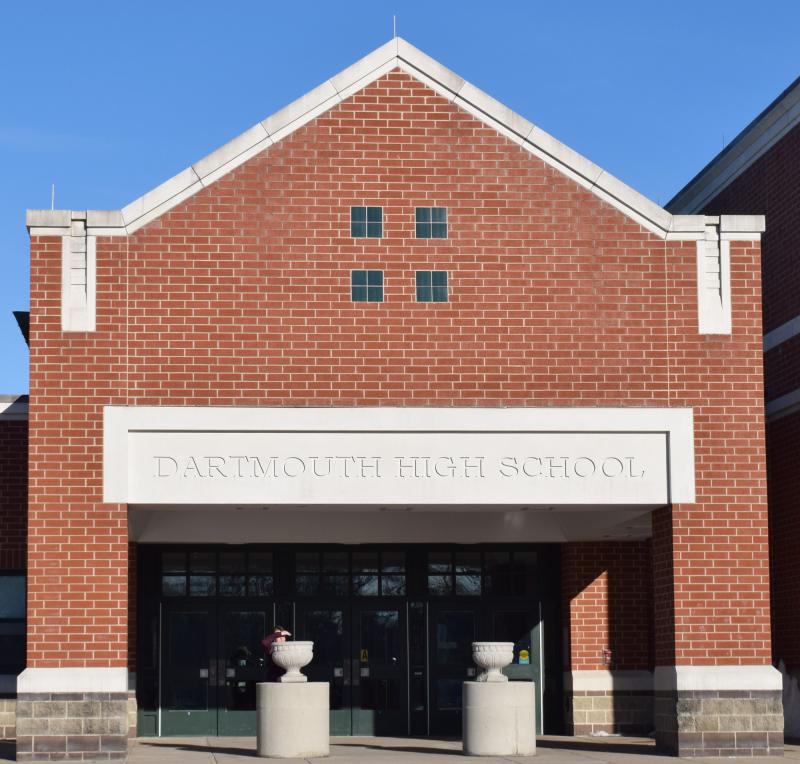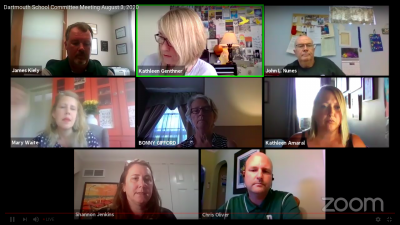School officials home in on hybrid reopening plan
Dartmouth school officials are focusing on fleshing out a hybrid model with alternating days for reopening public schools this fall, as the August 10 deadline for submitting a comprehensive reopening plan to the state looms near.
Superintendent Dr. Bonny Gifford said at an August 3 School Committee meeting that a full return is “impossible” given space requirements to ensure safety during the coronavirus pandemic. “There is no way we could get all of our students in” even using non-traditional teaching spaces like closets and cafeterias, she noted.
This leaves two real options: a hybrid model combining in-person with remote learning, and a full remote learning model. According to a recent district survey, between these two models, a majority of parents would prefer a hybrid model, and Gifford noted that the state does not recommend 100 percent remote learning at this time.
At the meeting Gifford outlined just what the hybrid model would look like: two cohorts of students would come to school on alternate days, with in-person lessons structured like a regular school day and teachers giving the same lesson to each group.
Every other day would be used for remote learning at home, during which the students can complete assigned projects, videos, and reading. Grades and attendance would be recorded as normal.
Officials are currently determining how best to split the student body into groups, with a priority on keeping siblings in the same cohort, she noted. The schools’ few high needs students would be allowed to attend every day.
Safety requirements in the building would include requiring face coverings and six feet of social distance at all times, hand sanitizer available in all rooms, hallways designated for one-way movement, and excessive furnishings removed from classrooms and other spaces for easier sanitizing and cleaning.
Lunches would be served in classrooms, supervision would be required in restrooms and hallways, and an isolation unit would be created in the nurse’s office. Students would be required to remain with their same cohort and grade level at all times.
As for transportation, Gifford stated, there would be one student per seat, or around 20 students per bus, including a section to isolate any student showing symptoms. Seats would be assigned and there would be one drop off and one pick up area only.
“[School Business Administrator Jim] Kiely is confident that we have the capacity to transport students in a hybrid method,” Gifford said.
Personal protective equipment already purchased by the schools for any student or staffer in need includes masks, gloves, gowns, safety glasses, sanitizer, and face shields.
According to the plan, any students who choose not to return to school will be able to learn through a remote platform provided by the district through state vendors.
The public schools’ special education students would receive primarily remote instruction, with more online services, support and structure than last spring. Those with complex and significant needs, and those in preschool, would receive in–person instruction “to the maximum extent feasible,” Gifford said.
Tech upgrades in preparation for either a hybrid or remote learning plan include electronic whiteboards installed throughout the district as well as upgrades to teachers’ laptops, preparations for expanded bandwidth, and cleaning and repairing Chromebooks for students’ use. “We have enough devices for everyone,” Gifford announced.
As far as a 100 percent remote learning plan, Gifford continued, it “is not recommended as of right now” by the Massachusetts Department of Elementary and Secondary Education.
“We’re continuing to push for as much in-person learning as possible,” Gifford noted. But if necessary, virtual lessons would be held live with teachers in the classroom and face-to-face lessons and assignments, with attendance recorded and grades earned as normal.
Sports would not be offered with a full remote learning plan, although officials have yet to make a decision regarding the hybrid plan. As for clubs, Gifford said, “we would try to keep as many as we could functioning,” with some moving online and others in person.
Kiely told officials at the meeting that funding for any of the reopening plans would come from the federal Coronavirus Aid, Relief, and Economic Security (CARES) Act, which provides for more than $1 million in funding for Dartmouth schools through the Coronavirus Relief Fund and the Elementary and Secondary Schools Emergency Relief Fund.
He also noted that municipal governments were granted CARES Act pandemic relief funding that could be used for school costs if necessary.
Dartmouth’s aid package came to more than $3 million.
School administrators will get feedback from the state on their plans by August 7, stated Gifford, and the district also plans to get more concrete feedback from parents on whether they plan to allow their students to attend school in person and whether they will be needing transportation.
School committee members thanked the administrators for their hard work before asking questions about ventilation, clubs, the weekly schedule, amount of PPE, and transportation, among other topics.
“The bottom line is, this district has determined that we cannot safely reopen the Dartmouth public schools at 100 percent capacity,” said Committee Chair Chris Oliver. “It's not feasible, it’s not safe, and that’s why it was taken off the table.”
Oliver went on to state that he is “not convinced” on the hybrid plan. “I’ve had questions come up, can you guarantee that my child will be safe in school, can you guarantee that staff are gonna be safe. No, we can’t,” he said. “Let’s just make that clear. We cannot guarantee that anyone will be 100 percent safe from Covid-19.”
He suggested that committee members visit the schools to see socially distanced and sanitized classrooms to get a better idea of what allowing students back would mean, an idea that was approved by other committee members. The visit is scheduled for August 6.
Comprehensive plans must be submitted to the state by August 10. The committee will have to vote on whether to implement the hybrid plan or a fully remote learning plan in just one week’s time.
The next School Committee meeting is set for August 10.













